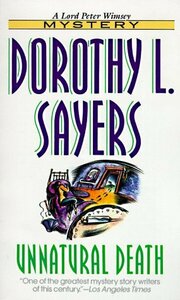Take a photo of a barcode or cover
Contains a delightful number of women who "don't care a thing for men" and are determined to set up house with their"best friends". Also contains some really awful racist language that is strictly incidental to the story but does not make the author particularly endearing, even by 1920s standards.
I realized part way through that I must have read this book years ago, because the name of cousin Hallelujah Dawson rang a bell. But most of the rest of it I had forgotten. It was a decent mystery, although I can see why I didn't become attached to it on the first read -- others in the series make Lord Peter more lovable/relatable. The one not so nice aspect of the book was the racism, including the use of the "n" word and the concept that a decent English person would not let one of "them" in their home. I admit that the sentiment was common and realistic in the UK in the 20s (and has not been completely eradicated in that country or this one yet, just prettied up quite a bit).
Unnatural Death is a tricky novel to read today because of Sayers' treatment of race and apparent disapproval of lesbianism. But it's a great study of Wimsey's ego and its consequences. As likeable as Wimsey is, this mystery does not show him in the best light.
The mystery revolves the death of a cancer patient, who may have been killed (slightly) before her time. But, even with a post-mortem, there is no evidence of murder, just Wimsey's belief that only failures are detected as murder (even if they remain unsolved), and that there must be a large proportion of murders that are never detected as unnatural deaths. He becomes interested in this case because he believes it to be a "successful" murder--one that did not raise any suspicions--and intends to detect it. During his investigation, more individuals are killed, and Wimsey is forced to reconcile his amateur interest in detection, which he treats as an intellectual exercise, and the repercussions to others.
Sayers' treatment of the only character of color does give pause. Yes, she is a woman of her time, but it's hard not to expect/hope for more from a writer you admire. Sayers was an Englishwoman with an Englishwoman's prejudices. She clearly identified with the social structure of the time, and had a certain amount of distrust of foreigners. Sayers' depiction of this character is pretty sympathetic, particularly for someone of her time, but, as another review has pointed out, Wimsey and Parker's decision to let the media run with an incorrect interpretation of a particular crime is the kind of reporting that would lead to things like lynchings in the American South of the same time period (and it's hard to imagine that Sayers was not aware of these extrajudicial killings). It's another example of Wimsey's ego at work--he is willing to cast suspicion on persons he knows to be innocent--in order to achieve his ends and capture the killer.
More than one reviewer has commented unfavorably on Sayers' apparent distaste for lesbianism, but I'm not sure that it's as simple as that. There are two tales of close female friendship, the story of Clara Whitaker and Agnes Dawson, both deceased at the start of the mystery, and of Mary Whitaker, the suspect, and her friend, Vera Findlater. The elder Ms. Whitaker and her lifelong friendship with Agnes Dawson is spoken of with admiration. If the two were lovers, which I think is what Sayers implies, they are not condemned by the people who knew them. Rather, they were generally well-loved.
But Ms. Climpson, who makes her debut in this novel, comments very unfavorably on Vera Findlater's "pash" for Mary Whitaker. She suggests that Vera really just needs to find a nice young man and that Mary is just using Vera. She also describes a same-sex relationship as unnatural or undesirable. I agree with a reviewer that Mary and Vera's relationship is probably an intimate one, but I don't know that the condemnation of Mary's character is also a comment on her lesbianism. From everything we learn about Mary, she is a cold woman who is focused solely on her own interest. I think Mary would have used a young man who had a crush on her in the same way, and with the same cold-bloodedness.
Nonetheless, Sayers' exploration of race and same-sex relationships does create some cognitive dissonance for the admiring reader.
The mystery revolves the death of a cancer patient, who may have been killed (slightly) before her time. But, even with a post-mortem, there is no evidence of murder, just Wimsey's belief that only failures are detected as murder (even if they remain unsolved), and that there must be a large proportion of murders that are never detected as unnatural deaths. He becomes interested in this case because he believes it to be a "successful" murder--one that did not raise any suspicions--and intends to detect it. During his investigation, more individuals are killed, and Wimsey is forced to reconcile his amateur interest in detection, which he treats as an intellectual exercise, and the repercussions to others.
Sayers' treatment of the only character of color does give pause. Yes, she is a woman of her time, but it's hard not to expect/hope for more from a writer you admire. Sayers was an Englishwoman with an Englishwoman's prejudices. She clearly identified with the social structure of the time, and had a certain amount of distrust of foreigners. Sayers' depiction of this character is pretty sympathetic, particularly for someone of her time, but, as another review has pointed out, Wimsey and Parker's decision to let the media run with an incorrect interpretation of a particular crime is the kind of reporting that would lead to things like lynchings in the American South of the same time period (and it's hard to imagine that Sayers was not aware of these extrajudicial killings). It's another example of Wimsey's ego at work--he is willing to cast suspicion on persons he knows to be innocent--in order to achieve his ends and capture the killer.
More than one reviewer has commented unfavorably on Sayers' apparent distaste for lesbianism, but I'm not sure that it's as simple as that. There are two tales of close female friendship, the story of Clara Whitaker and Agnes Dawson, both deceased at the start of the mystery, and of Mary Whitaker, the suspect, and her friend, Vera Findlater. The elder Ms. Whitaker and her lifelong friendship with Agnes Dawson is spoken of with admiration. If the two were lovers, which I think is what Sayers implies, they are not condemned by the people who knew them. Rather, they were generally well-loved.
But Ms. Climpson, who makes her debut in this novel, comments very unfavorably on Vera Findlater's "pash" for Mary Whitaker. She suggests that Vera really just needs to find a nice young man and that Mary is just using Vera. She also describes a same-sex relationship as unnatural or undesirable. I agree with a reviewer that Mary and Vera's relationship is probably an intimate one, but I don't know that the condemnation of Mary's character is also a comment on her lesbianism. From everything we learn about Mary, she is a cold woman who is focused solely on her own interest. I think Mary would have used a young man who had a crush on her in the same way, and with the same cold-bloodedness.
Nonetheless, Sayers' exploration of race and same-sex relationships does create some cognitive dissonance for the admiring reader.
adventurous
dark
informative
inspiring
lighthearted
mysterious
tense
medium-paced
Plot or Character Driven:
Plot
Strong character development:
No
Loveable characters:
Yes
Diverse cast of characters:
Complicated
Flaws of characters a main focus:
Complicated
funny
mysterious
slow-paced
Plot or Character Driven:
Plot
Strong character development:
No
Diverse cast of characters:
No
Flaws of characters a main focus:
No
Minor: Racial slurs, Suicide, Antisemitism, Religious bigotry
Wimsey and Detective Parker are in conversation at a restaurant when they are overheard by another diner. He presents them with a case in which he demanded an autopsy and the resultant gossip drove him out of town to set up a new practice. Lord Peter tells him that he will look into it and does not ask the man's name or specific of the case or when it was. He sends Bunter round next day to look up cases based on an approximate date and location. Bunter, of course, uncovers it and Peter begins to investigate. He introduces Charles Parker to Miss Climpson, an elderly gossipy lady who can find out the things he wishes to know from people and about people by simply being herself. he dispatches her to the town where he wants her to take a room and gives her precise instructions on her circumstances, income, etc. She sends him a weekly report on what she has learned and her opinions of the ongoing behavior and talk in the town. Peter, Charles and Bunter continue doing research on their end of the business - especially since a body turns up of a woman who used to work for the household where the death took place.
adventurous
mysterious
fast-paced
challenging
dark
emotional
funny
informative
inspiring
lighthearted
mysterious
sad
tense
slow-paced
Plot or Character Driven:
Character
Strong character development:
No
Loveable characters:
Yes
Diverse cast of characters:
Yes
Flaws of characters a main focus:
Yes
Murder mystery that turns on the minutiae and implementation timeline of an obscure piece of real estate law? Practically made for me.



